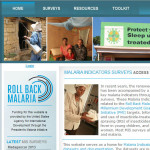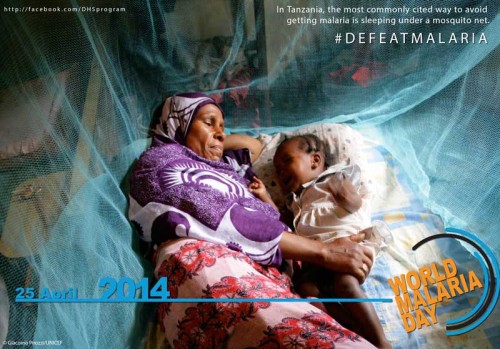World Malaria Day: What’s the Buzz?
It’s a health risk for more than half the world’s population. A child dies every minute because of it. There are 207 million annual cases worldwide. And 90% of the deaths from this disease (which kills 627,000 globally) occur in Sub-Saharan Africa (source: World Health Organization).
We’re buzzing about malaria. This preventable and curable mosquito-borne illness results from a multiplication of Plasmodium parasites within red blood cells which then burst, causing symptoms that typically include fever and headache. It’s especially dangerous to women and children in Sub-Saharan Africa, where biological, environmental, and socio-economic factors mean a greatly increased risk of malaria transmission. Those at highest risk include children age 6 months to 5 years, who haven’t yet developed partial immunity to the disease, and pregnant women, whose immunity to malaria is compromised.
Invest in the future: defeat malaria. That’s the theme for this year’s World Malaria Day (April 25th). Organizations, governments, communities, and donors have all worked hard to increase access to malaria prevention, diagnosis, and treatment…But there’s still a long way to go. At The DHS Program, we’ve made great strides in collecting and analyzing malaria data for current and future malaria control policy and programming efforts.
Here are 5 ways The DHS Program contributes to the effort to Roll Back Malaria:
1. Implementing malaria modules in the Demographic and Health Surveys (DHS), Service Provision Assessments (SPA), and Malaria Indicator Surveys (MIS).
The DHS Program collects data in many DHS, SPA, and MIS surveys on a number of malaria indicators, including ownership and use of insecticide-treat nets (ITNs) by children and pregnant women, prevalence and prompt treatment of fever in children, and intermittent preventive treatment of pregnant women (IPTp). In recent years, biomarker testing for anemia and parasitemia has been added, as well as other relevant questions.
DHS surveys with malaria modules have been conducted in more than 30 countries. Ten of these countries have also conducted MIS surveys since 2005: Angola, Burundi, Kenya, Liberia, Madagascar, Malawi, Nigeria, Senegal, Tanzania and Uganda. Find out more on our Malaria Corner.
2. Developing workshops on using population-based survey data for M&E malaria control.
 Population-based malaria survey data are widely used for monitoring and evaluation of programs by international donor organizations, but they remain underutilized by national malaria control programs. In order to strengthen professionals’ capacity in Sub-Saharan Africa, The DHS Program will host workshops later this year in Ghana and Burkina Faso along with partners MEASURE Evaluation, the University of Ghana School of Public Health, and the Research Center in Sante de Nouna (CRSN). These one-week workshops will provide training in effective use of population-based survey data (check back with us in a few months to hear more about the workshops).
Population-based malaria survey data are widely used for monitoring and evaluation of programs by international donor organizations, but they remain underutilized by national malaria control programs. In order to strengthen professionals’ capacity in Sub-Saharan Africa, The DHS Program will host workshops later this year in Ghana and Burkina Faso along with partners MEASURE Evaluation, the University of Ghana School of Public Health, and the Research Center in Sante de Nouna (CRSN). These one-week workshops will provide training in effective use of population-based survey data (check back with us in a few months to hear more about the workshops).
3. Analyzing malaria data for research studies.
The Analysis team at The DHS Program uses the data mentioned in #1 to undertake analytical studies and comparative reports. One such publication is this quantitative, multinational report which discusses preventing malaria during pregnancy in sub-Saharan Africa. This report discusses the determinants of effective IPTp delivery. Though many people tend to think about children and bednets when they hear about malaria, IPTp can be effective in preventing malaria among another high-risk group, pregnant women, but only when administered correctly.
4. Maintaining malariasurveys.org.
 Malariasurveys.org serves as a home to a comprehensive list of malaria indicator surveys, reports, and datasets. It also contains a list of resources on malaria and toolkits for survey implementation and use. This is one of the ways in which The DHS Program partners with Roll Back Malaria (RBM), the global framework designed to implement coordinated action against malaria.
Malariasurveys.org serves as a home to a comprehensive list of malaria indicator surveys, reports, and datasets. It also contains a list of resources on malaria and toolkits for survey implementation and use. This is one of the ways in which The DHS Program partners with Roll Back Malaria (RBM), the global framework designed to implement coordinated action against malaria.
5. Working with the Roll Back Malaria Consortium to help assess the impact of malaria control on child mortality in 15 countries.
The DHS Program also partners with Roll Back Malaria to carry out follow-up nationwide evaluations of the impact of malaria control on all-cause childhood mortality (ACCM) in focus countries over the past decade. These surveys provide updated information on household coverage of ITNs, appropriate diagnosis and treatment of malaria, and prevention of malaria in pregnant women and assess evidence of plausible associations between scale-up of these interventions and reductions in ACCM. The assessments are part of the larger RBM partnership’s evaluation of progress towards the 2015 Millennium Development Goals (MDGs). Learn more about the impact evaluations on the PMI website.
Do you use DHS data to learn about malaria? What’s your favorite malaria-related indicator?





